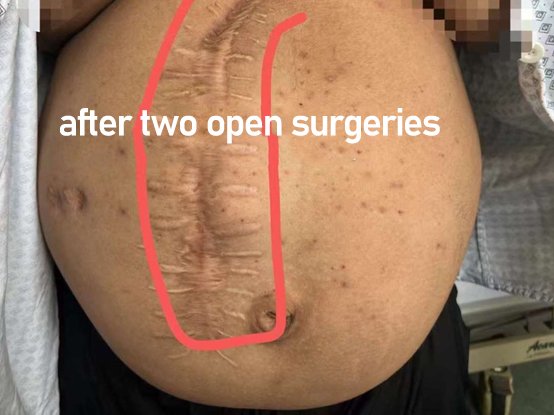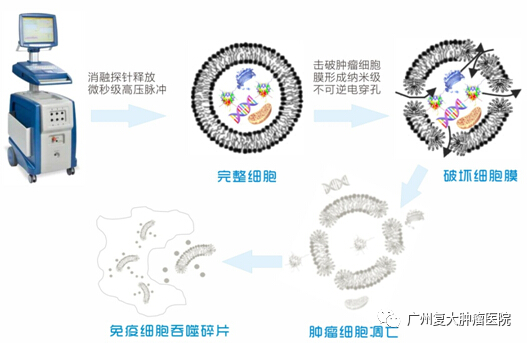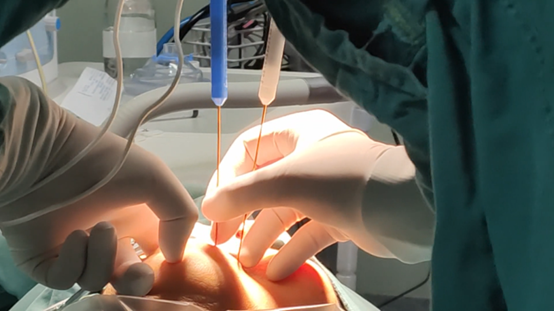"This patient weighs 300 pounds and has been suffering from a pancreatic neuroendocrine tumor and recurrent hypoglycemia for more than ten years. After undergoing two surgeries and one anhydrous alcohol ablation at another hospital, the tumor recurred again..." This is undoubtedly a complex and challenging case, extremely rare both domestically and internationally. Ultimately, after thorough consideration and expert consultations, it was decided to perform NanoKnife ablation for this patient.

What is NanoKnife Technology?
NanoKnife technology, also known as irreversible electroporation (IRE), is a novel non-thermal ablation technique that has gained popularity in recent years for treating tumors. Despite the word "knife" in its name, it actually uses electrical pulses. Under CT or ultrasound guidance, ablation probes are placed, and short-pulse, high-voltage direct current technology generates microsecond-level electrical pulses, creating multiple nano-scale irreversible electropores on the cell membrane. This disrupts the balance inside and outside the cell, leading to apoptosis (cell death).

The Evolution and Clinical Application of IRE
In the 1990s, scientists discovered that reversible electroporation using up to one kilovolt of energy could create reversible micropores in the cell membrane, allowing gene drugs or chemotherapy drugs to enter the cells, thus pioneering gene therapy and electrochemical therapy. In China, basic research and equipment development for the clinical application of irreversible electroporation began around 2002.

Research by Rubinsky et al. in the United States found that increasing the voltage to three kilovolts in the target area would create irreversible micropores in the cell membrane, inducing apoptosis and activating the mononuclear-phagocyte system to engulf and clear apoptotic cells. With further research, NanoKnife technology was approved by the FDA in 2012 for clinical oncology treatment and in June 2015, it was approved for clinical use in China. In July of the same year, my colleagues and I performed the first NanoKnife ablation surgery for pancreatic cancer in mainland China.

The First NanoKnife Surgery in Mainland China
Traditional ablation techniques are mainly used for solid tumors in the liver, gallbladder, and kidneys. The pancreas, with its dense network of surrounding ducts, poses a significant risk—any slight error could cause vascular rupture or bile duct injury. However, NanoKnife technology boldly tackles these high-difficulty "king of cancers" surgeries. Two steel needles, one positive and one negative, precisely target the tumor, bypassing ducts, and use high-voltage electrical pulses to penetrate tumor cells. The process of using NanoKnife to ablate pancreatic cancer is extremely complex and challenging, requiring a highly skilled surgical team and comprehensive diagnostic and treatment capabilities from the hospital.

Record-Breaking Surgery
On August 11, 2016, I performed a NanoKnife surgery on an 89-year-old woman with pancreatic cancer, setting the record for the oldest patient globally to undergo this procedure. The patient was from the Philippines and had previously undergone surgery, but local doctors found the tumor inoperable upon opening her abdomen and had to close it back up. She came to Guangzhou Fuda Cancer Hospital on August 7th for treatment. The pancreas is surrounded by many important blood vessels and organs, making it difficult to determine the puncture location. Additionally, the patient had numerous underlying conditions like diabetes and hypertension, with fragile blood vessels that could easily cause massive bleeding or complications like bile or intestinal leaks. After a comprehensive evaluation, the hospital found that NanoKnife was the most effective method available to help her. A week after the surgery, her tumor markers significantly decreased, and her condition was under control.
Achievements and Future Prospects
As of March 2024, Guangzhou Fuda Cancer Hospital has completed 1,007 NanoKnife ablation procedures, leading the nation in both the quantity and quality of ablations, and has accumulated rich experience. Additionally, the hospital has published nearly 50 research papers related to NanoKnife, including more than 20 SCI papers, and published the first domestic monograph on NanoKnife ablation, "New Techniques in Tumor Ablation—Irreversible Electroporation," in August 2014, contributing significantly to the advancement of NanoKnife ablation technology.

It is worth noting that during the process of "electrifying" cancer cells, researchers found that electrical treatment of cancer tissues combined with immunotherapy could greatly improve the survival time of cancer patients. This is because NanoKnife can act as a powerful trigger for immune responses, promoting the massive release of tumor antigens hidden within cells, becoming an "in situ tumor vaccine" that induces local and systemic immune responses. As an "electro-immunomodulation therapy," NanoKnife, when combined with immunotherapy, exhibits synergistic effects. However, preclinical research on the combination of NanoKnife and immunotherapy still needs to delve deeper into the related mechanisms, and clinical practice requires more large-scale, multicenter, prospective clinical data to determine the best strategies (including timing and dosage) for combining NanoKnife with immunotherapy, ultimately benefiting more cancer patients.